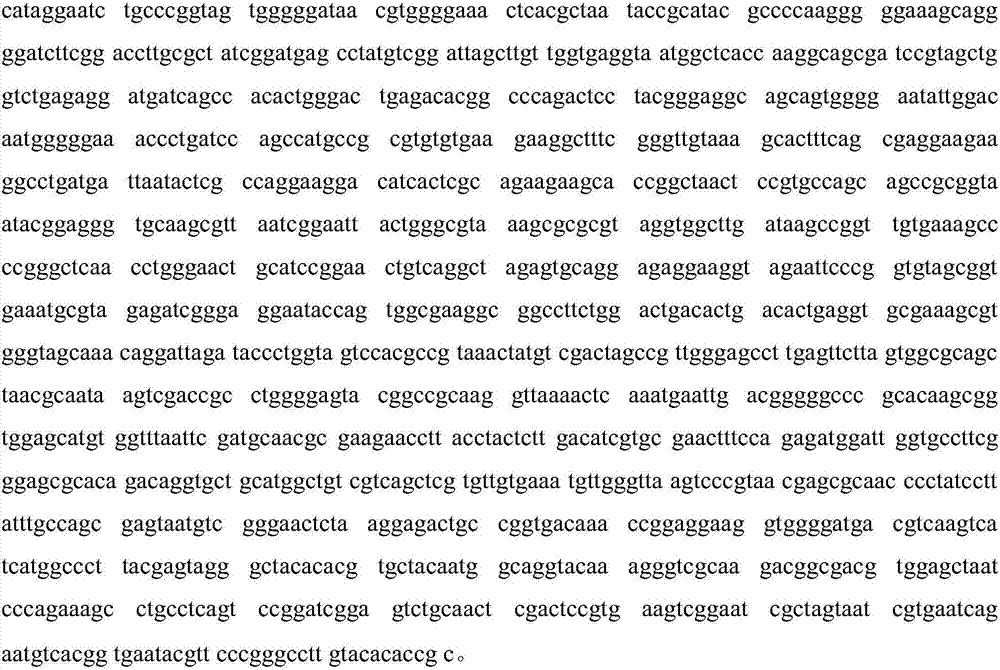Method for preparing heavy metal adsorbent by utilizing marine salt monoucleosis strains
A technology of Halomonas and heavy metals, applied in the field of water treatment, can solve the problems of low adsorption efficiency of adsorbents and high adsorption efficiency of heavy metal adsorbents, and achieve the effects of stable performance, strong adsorption capacity and high adsorption efficiency
- Summary
- Abstract
- Description
- Claims
- Application Information
AI Technical Summary
Problems solved by technology
Method used
Image
Examples
Embodiment 1
[0031] A method for preparing a heavy metal adsorbent by using a marine Halomonas strain, including the following steps:
[0032] (1) Inoculate the selected strain of Halomonas sp.GHF11 on a solid culture medium at 25°C for 36 hours, add sterile water to make a strain, and the volume ratio of the sterile water to the solid medium 1:1;
[0033] (2) Inoculate the bacterial seed liquid into the liquid culture medium, the inoculation concentration is 0.6mL bacterial seed liquid / 100mL liquid medium, ferment culture at 25℃ for 3 days, the shaking speed of the shaker is 80r / min, make the fermentation bacterial liquid ;
[0034] (3) Dialysis and centrifugation of the fermentation broth to remove part of the medium components to obtain the supernatant. The specific process is: place the fermentation broth on a rotary evaporator and concentrate it under reduced pressure at 60°C to 10% of the original volume. Put it into a dialysis bag with a molecular weight cut-off of 8000 Daltons and dialy...
Embodiment 2
[0039] A method for preparing a heavy metal adsorbent by using a marine Halomonas strain, including the following steps:
[0040] (1) Inoculate the selected strain of Halomonas sp.GHF11 on a solid medium at 28°C for 42 hours, add sterile water to make a strain, and the volume ratio of sterile water to solid medium 1.25:1;
[0041] (2) Inoculate the bacterial seed liquid into the liquid culture medium, the inoculation concentration is 0.8mL bacterial seed liquid / 100mL liquid medium, ferment culture at 28℃ for 4 days, the shaker vibration speed is 130r / min, make the fermentation bacterial liquid ;
[0042] (3) Dialysis the fermentation broth to remove part of the medium components and centrifuge to obtain the supernatant. The specific process is: place the fermentation broth on a rotary evaporator and concentrate it under reduced pressure at 62°C to 12% of the original volume. Put it into a dialysis bag with a molecular weight cut-off of 8000 Daltons and dialyze with deionized water ...
Embodiment 3
[0047] A method for preparing a heavy metal adsorbent by using a marine Halomonas strain, including the following steps:
[0048] (1) Inoculate the selected strain of Halomonas sp.GHF11 on the solid medium at 30°C for 48 hours, add sterile water to make the strain, and the volume ratio of the sterile water to the solid medium 1.5:1;
[0049] (2) Inoculate the bacterial seed liquid into the liquid culture medium, the inoculation concentration is 1.0mL bacterial seed liquid / 100mL liquid medium, ferment culture at 30℃ for 5 days, the shaking speed of the shaker is 150r / min, make the fermentation bacterial liquid ;
[0050] (3) Dialysis and centrifugation of the fermentation broth to remove part of the medium components to obtain the supernatant. The specific process is: place the fermentation broth on a rotary evaporator and concentrate it under reduced pressure at 65°C to 15% of the original volume. Put it into a dialysis bag with a molecular weight cut-off of 8000 Daltons and dialyz...
PUM
 Login to View More
Login to View More Abstract
Description
Claims
Application Information
 Login to View More
Login to View More - Generate Ideas
- Intellectual Property
- Life Sciences
- Materials
- Tech Scout
- Unparalleled Data Quality
- Higher Quality Content
- 60% Fewer Hallucinations
Browse by: Latest US Patents, China's latest patents, Technical Efficacy Thesaurus, Application Domain, Technology Topic, Popular Technical Reports.
© 2025 PatSnap. All rights reserved.Legal|Privacy policy|Modern Slavery Act Transparency Statement|Sitemap|About US| Contact US: help@patsnap.com


